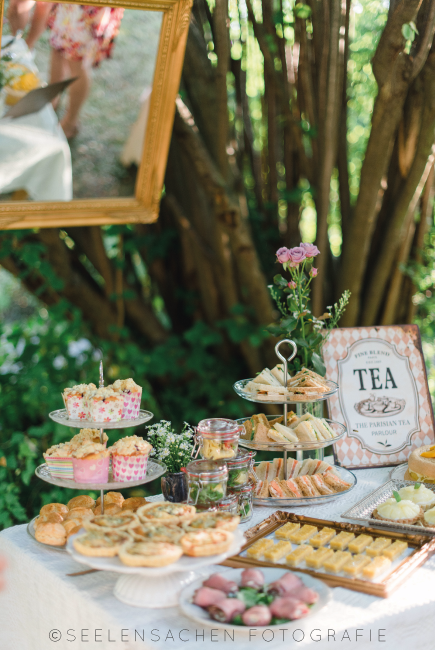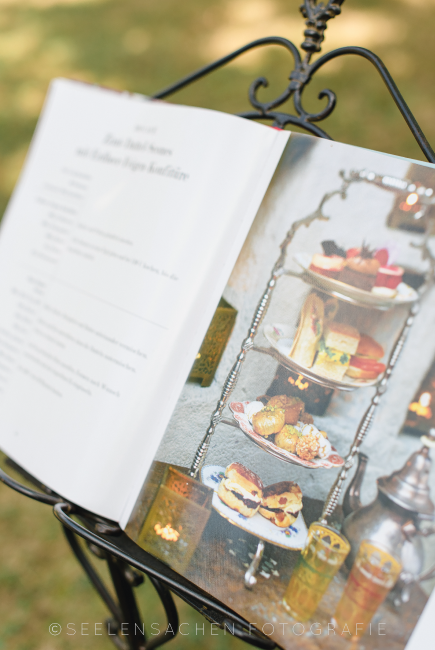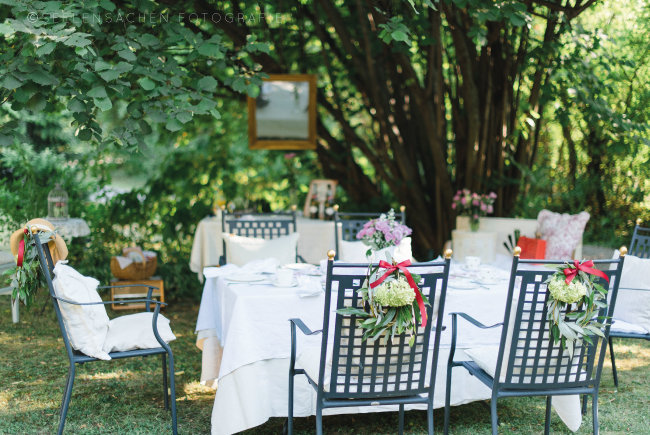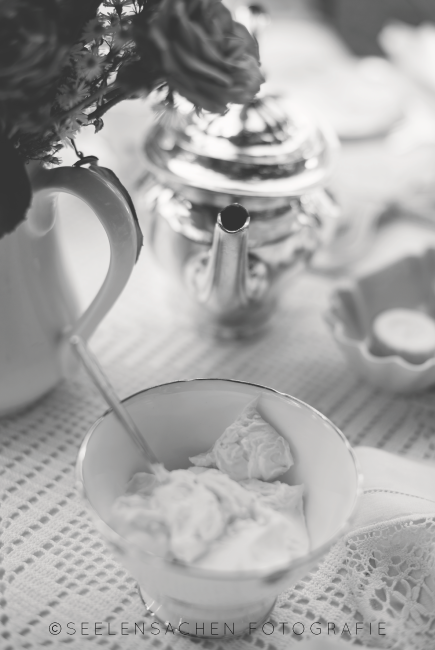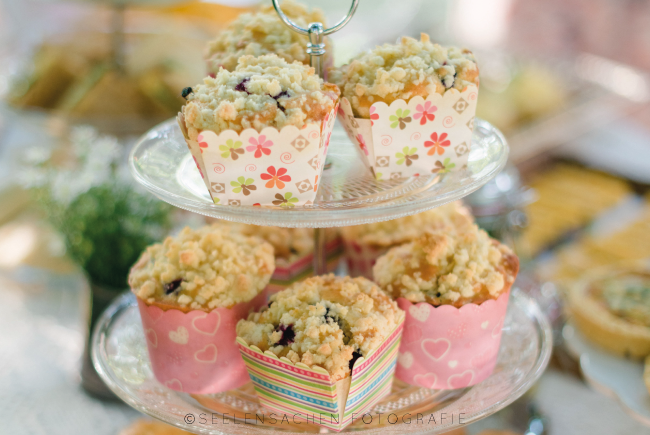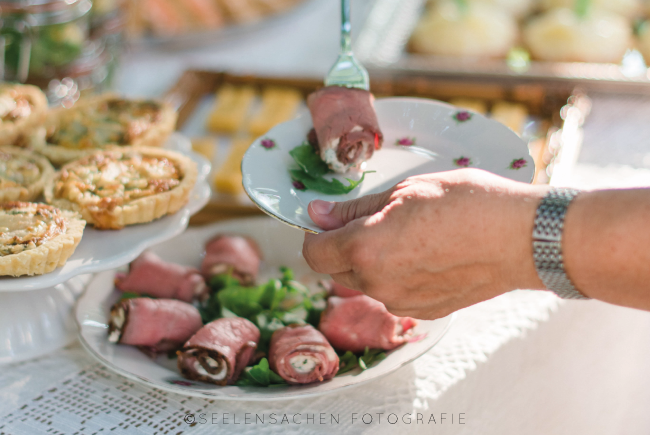
In this blog post I will tell you something about the various meals, also referred to as „tea“. And I will also present you with some delicious recipes for blueberry muffins with streusel topping and roast beef rolls.
But before indulging in the characteristics of the various forms I want to announce the winners of my give-away. … *Drum-roll*
The winners are:
Doro of kochgehilfin.de (German book)
Lia Lozic – the vintage_table (English book)
Congratulations! I hope you’ll like the books. Now, there’s now reason why your friends shouldn’t be invited for afternoon tea very soon! 😉
Doro and Lia, please send me an email at simone@myblueberrybasket.com with your full name and full address so I can dispatch the book to you.
Well now, let’s come back to the next issue of my afternoon tea series. So far, I have only told you about “afternoon tea”. As a matter of fact, there are more forms of “tea”-meals or simple occasions where it is customary to drink tea.
Afternoon Tea
Afternoon Tea has aristocratic roots and is taken around 4 o’clock in the afternoon. Apart from a pot of delicious tea you will also be served scones with clotted cream and jam along with a selection of cakes, pastries and little savories, mainly sandwiches. The hosts and guests often sit in the living room, on a sofa or low parlor chair, with the tea and the food being served on a low tea table.
High Tea
In contrast to the aristocratic connection of the afternoon tea, the high tea is assumedly related to the working class. It was during the Industrial Revolution that most people did no longer work at home. After a long working day they often returned home with a hungry stomach and they would have a proper meal at around 5 or 6 in the late afternoon or early evening. By that time, however, tea had become affordable and part of a stable diet. So tea was served for this meal, along with some hearty dishes like meats, bread and also scones and cakes. The reason why this meal is called High Tea is that people would be sitting at a proper, full size table.
Cream Tea
This is a simpler version of the big afternoon tea. You enjoy a pot of tea with scones, clotted cream and strawberry jam. Still, this being such an English tradition, it is a real pleasure to have cream tea in England, particularly if you are in one of the many cosy tea rooms which can be found all over the country.
These are the three most important versions of meals which include the drinking of tea. But of course, the English always find an occasion to enjoy a cup of tea. So you would find Picnic Teas, Cricket Teas, Christmas Holiday Teas, Christening Teas, Farewell Teas, and so on. After all, tea is not only a suitable drink at social gatherings and occasions, it can also be regarded as a comforter in every situation, a remedy for almost every ailment and most importantly, a reason and a good excuse to sit back and relax for a few minutes.
Once again, I want to thank Nora from Seelensachen Fotografie for her wonderful photos. Thank you! 😊
Blueberry Muffins with Streusel Topping
For about 15 muffins
2 cups (230 g) flour, all-purpose
2 teaspoons baking powder
1/3 – 1/2 cup (100 g) butter (room-temperature)
½ cup (100 g) sugar
some vanilla extract
3 medium-sized eggs
1 pinch of cardamom (optional)
1/3 cup (75 ml) buttermilk
1 tablespoon flour
½ lb (250 g) blueberries, fresh
For the Streusel Topping:
2/3 cups (80 g) flour, all-purpose
¼ cup (50 g) butter
¼ cup (40 g) sugar
Preheat the oven to 200°C (180°C fan, 400°F, gas mark 6).
Beat the butter, sugar, vanilla, eggs, cardamom and buttermilk until well combined. Add 2 cups (230 g) flour and the baking powder and beat again.
Coat the blueberries with 1 tablespoon flour and carefully fold them into the batter.
For the streusel topping combine the flour and the sugar. Rub the cold butter into the flour until you get crumbs.
Line two muffin trays with paper muffin cases. Fill the muffin cases two-thirds full and sprinkle the crumbly mixture over the tops of the muffin batter. Bake for about 20 – 25 minutes.
Roast Beef-Rolls
For 12 roast beef-rolls
12 thin slices of ready cooked roast beef
1 cup (250 g) curd cheese or cream cheese
about 3-4 (30 g) dried tomatoes (drained of any oil)
1 handful of arugula
1 teaspoon of grated horseradish
salt, pepper
Chop the tomatoes and the arugula and mix them with the curd/cream cheese and the horseradish. Season with salt and pepper. Spread each roast beef slice with some of the filling and roll it up. Serve with some dark bread.
Roast Beef
2 lb (1 kg) beef sirloin
2 tablespoons Dijon mustard
1 tablespoon mild mustard
salt, pepper
some oil
Rub salt, pepper and mustard generously into the meat. Cover it and put it into the fridge for at least 4 hours, best overnight. Bring to room temperature before continuing.
Preheat the oven to 80°C (180°F).
Heat the oil in a pan and sear the meat until it is brown on all sides. Transfer to a roasting pan and roast in the oven for about 2 hours. Towards the end keep checking the core temperature of the meat. When a thermometer inserted into the thickest part of the beef reads 55°-60°C (131°-140°F) the beef is medium-rare and ready. It is difficult to suggest an exact time as the cooking time varies according to the size and thickness of the meat. Therefore, the use of a meat thermometer is highly recommended.
When the beef is cooked, take it out of the oven, cover it and leave to stand for 20 minutes before carving it up.
If you want to use the cooked roast beef for the above described rolls, the beef is best cooked on the previous day and stored in the fridge.
The amount of this roast beef exceeds the demand for the roast beef rolls. But you should consider that beef tastes much better if cooked in a larger chunk.
Suggestions for left-over roast beef:
- Put thinly sliced roast beef on a plate and spread lentil salad (lentils, spring onions, vinegar, oil, salt) on top
- Roast beef sandwiches: spread cream cheese on some brown bread and season with salt and pepper. Sprinkle some freshly grated horseradish on top and put thin slices of roast beef on the bread. Put another slice of bread on top.
- Spread some arugula on a plate. Put thinly sliced roast beef on top. Sprinkle with pomegranate seeds and a dressing of olive oil, lemon juice, salt and some pomegranate juice.
Here are the recipes for printing:
- [b]About 15 muffins[/b]
- 2 cups (230 g) flour, all-purpose
- 2 teaspoons baking powder
- 1/3 – 1/2 cup (100 g) butter (room-temperature)
- ½ cup (100 g) sugar
- some vanilla extract
- 3 medium-sized eggs
- 1 pinch of cardamom (optional)
- 1/3 cup (75 ml) buttermilk
- 1 tablespoon flour
- ½ lb (250 g) blueberries, fresh
- [br]
- [b]For the Streusel Topping:[/b]
- 2/3 cups (80 g) flour, all-purpose
- ¼ cup (50 g) butter
- ¼ cup (40 g) sugar
- Preheat the oven to 200°C (180°C fan, 400°F, gas mark 6).
- Beat the butter, sugar, vanilla, eggs, cardamom and buttermilk until well combined. Add 2 cups (230 g) flour and the baking powder and beat again.
- Coat the blueberries with 1 tablespoon flour and carefully fold them into the batter.
- For the streusel topping combine the flour and the sugar. Rub the cold butter into the flour until you get crumbs.
- Line two muffin trays with paper muffin cases. Fill the muffin cases two-thirds full and sprinkle the crumbly mixture over the tops of the muffin batter. Bake for about 20 – 25 minutes.
- [b]For 12 roast beef-rolls[/b]
- 12 thin slices of ready cooked roast beef
- 1 cup (250 g) curd cheese or cream cheese
- about 3-4 (30 g) dried tomatoes (drained of any oil)
- 1 handful of arugula
- 1 teaspoon of grated horseradish
- salt, pepper
- Chop the tomatoes and the arugula and mix them with the curd/cream cheese and the horseradish. Season with salt and pepper. Spread each roast beef slice with some of the filling and roll it up. Serve with some dark bread.
- 2 lb (1 kg) beef sirloin
- 2 tablespoons Dijon mustard
- 1 tablespoon mild mustard
- salt, pepper
- some oil
- Rub salt, pepper and mustard generously into the meat. Cover it and put it into the fridge for at least 4 hours, best overnight. Bring to room temperature before continuing.
- Preheat the oven to 80°C (180°F).
- Heat the oil in a pan and sear the meat until it is brown on all sides. Transfer to a roasting pan and roast in the oven for about 2 hours. Towards the end keep checking the core temperature of the meat. When a thermometer inserted into the thickest part of the beef reads 55°-60°C (131°-140°F) the beef is medium-rare and ready. It is difficult to suggest an exact time as the cooking time varies according to the size and thickness of the meat. Therefore, the use of a meat thermometer is highly recommended.
- When the beef is cooked, take it out of the oven, cover it and leave to stand for 20 minutes before carving it up.
- If you want to use the cooked roast beef for the above described rolls, the beef is best cooked on the previous day and stored in the fridge.
- The amount of this roast beef exceeds the demand for the roast beef rolls. But you should consider that beef tastes much better if cooked in a larger chunk.
